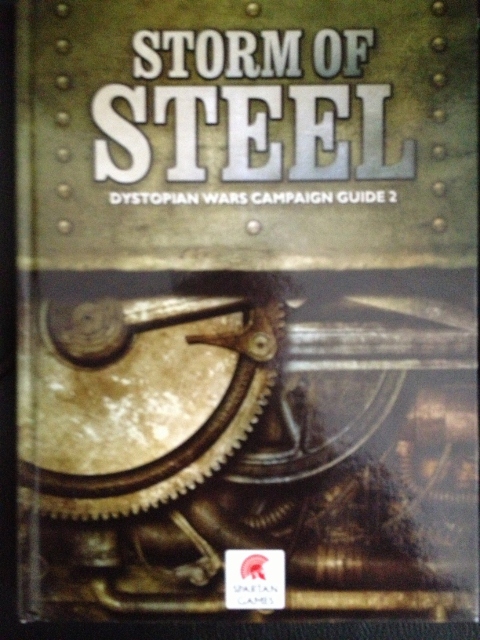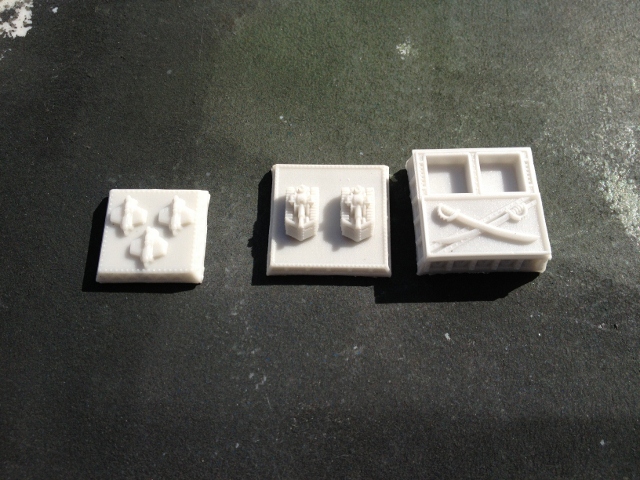Over the weekend, my new copy of Storm of Steel, the latest campaign supplement for Dystopian Wars, arrived. After having spent a couple of days going over it, I think I can safely say that Storm of Steel has surpassed the previous supplement, Hurricane Season, in just about every way!
 Contents
Contents
This book clocks in at 137 pages, compared to Hurricane Season’s 121. In those 130-odd pages, there is background material, new MARs, new game rules, stats for 16 new units, and a selection of new scenarios. Rather than skip around, I thought it would make more sense to discuss these elements chronologically in the order they appear in the book.
Background
The first 80 pages of Storm of Steel detail the back story of two major events in the Western Europe theater of operations; a joint Britannian-Russian intervention in Belgium, and a French invasion of southern England. The book more or less picks up where Hurricane Season left off, as these events are set between April and September of 1871. These 80 pages go into the same exacting detail on the force commanders, units, and timeline that Hurricane Season did for the battles in the Atlantic, which really adds to our understanding of the political landscape in the world of Dystopian Wars. One improvement that Storm of Steel has over its predecessor is that it also includes maps that indicate the flow of both the overall campaign and specific battles. This helps to ground the proceedings in reality a bit more than was the case in Hurricane Season.
New Rules
Up next is a section of new rules referred to as “Game Extensions.” These range from the description of how new weapon systems (such as Flame Weapons) work, to rules for using new terrain (such as Roads). Also included here are the rules for taking characters, awkwardly referred to as “Personality Fleet Commodores.” I guess GW has copyright on the term “Special Character!” As defined here, these commodores MUST be taken with a specific model, the stats for which are given later in the book. Another noteworthy feature is the inclusion of time of day rules, with different effects for twilight and night time. However, not everything in this section is truly “new.” also included are the rules for the Heat Lance and Cloud Generator, for example, which were previously available in the Republique of France booklet.
Infantry Rules
And now, we come to what is perhaps the most anticipated element of Storm of Steel, the introduction of infantry models into the game. There are 4 pages of rules that describe this new element, so I’m going to try and briefly summarize them here. Rather than model individual soldiers, infantry are represented by tokens representing an entire regiment (historically, a regiment is about 1,000 men, though this could vary wildly). Each token has one of 5 symbols on it that determine the type of regiment. These 5 options are Line Infantry, Reserve, Cavalry, Artillery, and Engineer. Each type of infantry has different abilities; Line Infantry can help defend larger models from boarding, for example, while Engineers can help models repair the effects of critical hits.
The tokens also have two slots on them that can hold a tiny D6. The white ones indicate the strength of the regiment, while the green ones represent the “Fatigue” of the regiment. At first glance, Infantry work a lot like tiny fliers do, in that they have 360 degree movement, and lose Fatigue in ways very similar to the manner that tiny fliers lose fuel. However, there are a number of unique wrinkles in the way that Infantry interact with each other and other models, some of which are counter-intuitive. For example, while bombs from a bomber or other flying model can be dropped on a regiment, bombs from tiny flyer dive bombers cannot.
Overall, based on my first couple of read-throughs, I think the infantry tokens add a nice dimension to the DW ground game; they don’t strike me as over-powered, but they don’t strike me as useless either. The tokens themselves are definitely the beefiest tokens we’ve gotten from Spartan yet, though!

From left to right, a RoF tiny flyer token, a PE small tank token, and one of the new infantry tokens.
New MARs
After the infantry rules, we get two pages of new Model Assigned Rules, or MARs. However, there really isn’t all that much that’s truly new here. Like with the game extensions, many of the MARs presented here were also released in the French fleet booklet. Many of the remainder are tied to the introduction of the infantry rules, such as the “Anti-Infantry (Weapon)” rule. Still, there are a couple of noteworthy new additions. For example, the “Limited Availability (Value)” rule restricts the deployment of certain models in a new way. For example, if a certain battleship were to have “Limited Availability 500,” you would only be able to take 1 at 0-500 points, 2 at 501-1000 points, 3 at 1001-1500 points, and so on. This seems like an interesting new balance tool, and it makes me wonder if we will see it retroactively applied to any existing models.
Scenarios
This book contains 5 new scenarios, and they are an interesting blend of land, sea, and combined land-sea games. Like with Hurricane Season, these scenarios (well, 4 of them anyway) can be played together to form a linked campaign of sorts. Also like Hurricane Season, each scenario gives a detailed “historical” order of battle, which players can either use or modify as desired. Storm of Steel’s scenarios also feature distinct victory conditions, modifying the Campaign Point (CP) system introduced by Hurricane Season. Whereas in the first book, destroying a certain class of ship always yielded a certain amount of CP, these values are now different depending on the scenario. There are also numerous other objectives that can be accomplished that provide “bonus” CP. While the first book also had these secondary objectives, there are many more and they are much more detailed in Storm of Steel.
Model Stats
The next major part of the book (about 26 pages or so) are dedicated to model stats. The first 10 pages are a re-print of the stats from the Republique of France fleet book; between this section, the MARs section, and the section on Game Extensions, this gives an owner of Storm of Steel access to all of the French rules for the game (if not the detailed background). After the French comes perhaps the next most anticipated feature of Storm of Steel after the infantry, the introduction of the minor nations. These include Belgium (2 units), Canada (6 units), Denmark (2 units), the Polish-Lithuanian Commonwealth (5 units), and Prussian Scandanavia (2 units). Also included in this section of the book are a series of stats for numerous buildings and emplacements used in the 5 scenarios, the stats for the four Personality Commodores (one each for France, Britannia, Prussia, and Russia), and the stats for the Titan-class transport. The Titan class is the “not-Titanic” model Spartan released earlier, and though the stats are identical for some reason they changed the name from Olympic to Titan.
End Matter
The last few pages of the book contain the most recent errata and clarifications for the rulebook (an interesting move considering how often these tend to change), as well as a page of tokens and terrain. The tokens are used by the new MARs and Generators introduced in the book, while the terrain consists of three oil platforms and a bridge section that is used in a few of the scenarios.
Conclusion
I really like this book! Just like Hurricane Season, Storm of Steel contains a massive amount of new background information, some cool new rules and scenarios, and new models all wrapped in a glossy hardcover package. It is important to note that Storm of Steel represents a huge boost to DW ground games. Not only do the Infantry tokes add a new dimension to ground games, 13 of the 17 new units from the minor nations are ground units (the exact breakdown is 13 land, 2 aerial, and 2 naval). The personality commodores, besides adding a nice bit of flavor, also boost the ground game as the ones in this book are all attached to land models.
That being said, this book is not without its drawbacks. First of all, the CoA, EotBS, and FSA play no part in the events of the book. While that does not prevent one of these factions from using one of the scenarios via the alternate force composition option, it does mean that there is really no new background or units for them. This might make Storm of Steel a hard sell for some of the players of these factions; in that case, it really comes down to how much the infantry rules, new scenarios, and the rules for the French and minor nations are worth to them. Another unfortunate omission are the Russian rules; despite the faction being prominently featured in the events of the book, it contains only the French rules. Likely, this omission was due to either the Russian rules not being finalized in time and/or space constraints. In the case of the later, though, I would have rather had 10 less pages of background fluff (out of the 80+ included) and had the stats for the Russian models included.
So, overall I think Storm of Steel is a worthy successor to Hurricane Season. While it is not perfect, and does not have something for everyone, it does an admirable job of expanding the Dystopian universe and improving the scope of the ground element of the game. Even if you do not play Britannia, Prussia, Russia, or France, I think this book would be a worthwhile buy for that reason.

I agree with the review, it’s a very good supplement. My beef with the book is the somewhat lop-sided alliance nations. There’s some great stuff (assault zeppelin airdropping mechs, anyone?), but they don’t complement the main nations very well. Do the Prussians really need another close-range airship? As cool as the Canadian tanks are, are they not duplicating the role of the basic Britannian MkII? The Belgian tank is a good mid-range main battle tank….but is an ally of both the French and Britannians, who already have one. The Prussians, who would have really benefitted from the tank, miss out.
On the other hand, that’s pretty much the only flaw I can find find. Great book.